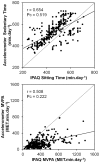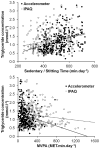Objective vs. self-reported physical activity and sedentary time: effects of measurement method on relationships with risk biomarkers
- PMID: 22590532
- PMCID: PMC3348936
- DOI: 10.1371/journal.pone.0036345
Objective vs. self-reported physical activity and sedentary time: effects of measurement method on relationships with risk biomarkers
Abstract
Purpose: Imprecise measurement of physical activity variables might attenuate estimates of the beneficial effects of activity on health-related outcomes. We aimed to compare the cardiometabolic risk factor dose-response relationships for physical activity and sedentary behaviour between accelerometer- and questionnaire-based activity measures.
Methods: Physical activity and sedentary behaviour were assessed in 317 adults by 7-day accelerometry and International Physical Activity Questionnaire (IPAQ). Fasting blood was taken to determine insulin, glucose, triglyceride and total, LDL and HDL cholesterol concentrations and homeostasis model-estimated insulin resistance (HOMA(IR)). Waist circumference, BMI, body fat percentage and blood pressure were also measured.
Results: For both accelerometer-derived sedentary time (<100 counts.min(-1)) and IPAQ-reported sitting time significant positive (negative for HDL cholesterol) relationships were observed with all measured risk factors--i.e. increased sedentary behaviour was associated with increased risk (all p ≤ 0.01). However, for HOMA(IR) and insulin the regression coefficients were >50% lower for the IPAQ-reported compared to the accelerometer-derived measure (p<0.0001 for both interactions). The relationships for moderate-to-vigorous physical activity (MVPA) and risk factors were less strong than those observed for sedentary behaviours, but significant negative relationships were observed for both accelerometer and IPAQ MVPA measures with glucose, and insulin and HOMA(IR) values (all p<0.05). For accelerometer-derived MVPA only, additional negative relationships were seen with triglyceride, total cholesterol and LDL cholesterol concentrations, BMI, waist circumference and percentage body fat, and a positive relationship was evident with HDL cholesterol (p = 0.0002). Regression coefficients for HOMA(IR), insulin and triglyceride were 43-50% lower for the IPAQ-reported compared to the accelerometer-derived MVPA measure (all p≤0.01).
Conclusion: Using the IPAQ to determine sitting time and MVPA reveals some, but not all, relationships between these activity measures and metabolic and vascular disease risk factors. Using this self-report method to quantify activity can therefore underestimate the strength of some relationships with risk factors.
Conflict of interest statement
Figures



References
-
- Gill JM, Cooper AR. Physical activity and prevention of type 2 diabetes mellitus. Sports Med. 2008;38:807–824. - PubMed
-
- Nocon M, Hiemann T, Muller-Riemenschneider F, Thalau F, Roll S, et al. Association of physical activity with all-cause and cardiovascular mortality: a systematic review and meta-analysis. Eur J Cardiovasc Prev Rehabil. 2008;15:239–246. 10.1097/HJR.0b013e3282f55e09 [doi];00149831-200806000-00001 [pii] - PubMed
-
- Katzmarzyk PT, Church TS, Craig CL, Bouchard C. Sitting time and mortality from all causes, cardiovascular disease, and cancer. Med Sci Sports Exerc. 2009;41:998–1005. 10.1249/MSS.0b013e3181930355 [doi];00005768-200905000-00005 [pii] - PubMed
-
- Dunstan DW, Barr EL, Healy GN, Salmon J, Shaw JE, et al. Television viewing time and mortality: the Australian Diabetes, Obesity and Lifestyle Study (AusDiab). Circulation. 2010;121:384–391. CIRCULATIONAHA.109.894824 [pii];10.1161/CIRCULATIONAHA.109.894824 [doi] - PubMed
Publication types
MeSH terms
Substances
LinkOut - more resources
Full Text Sources
Medical
Miscellaneous

